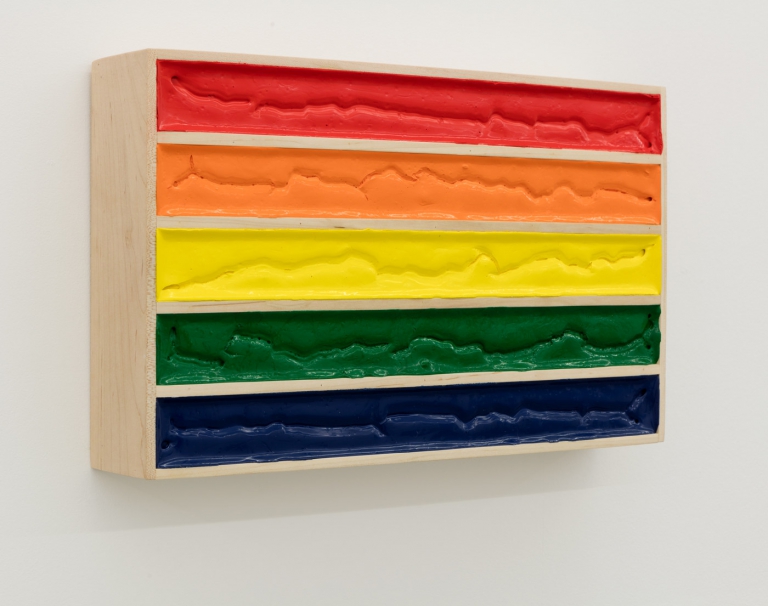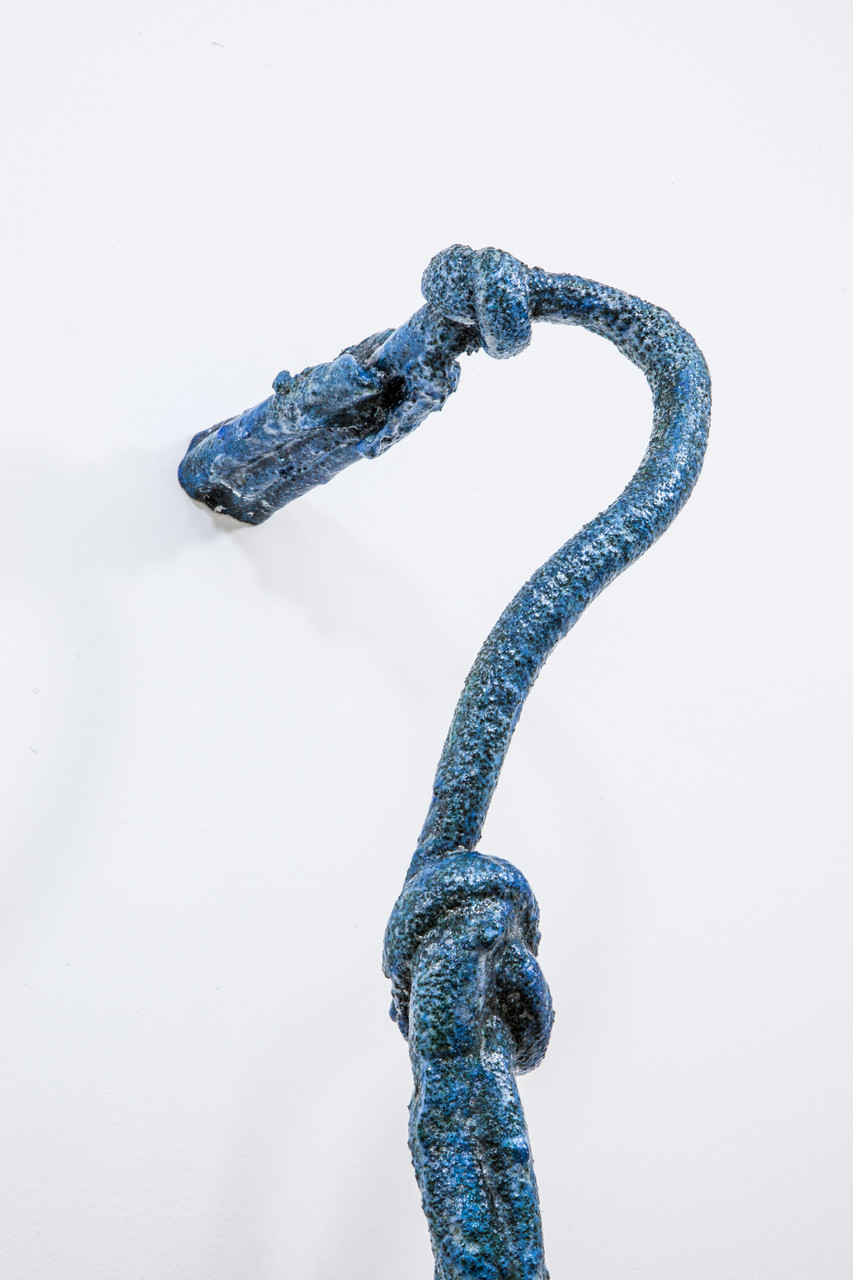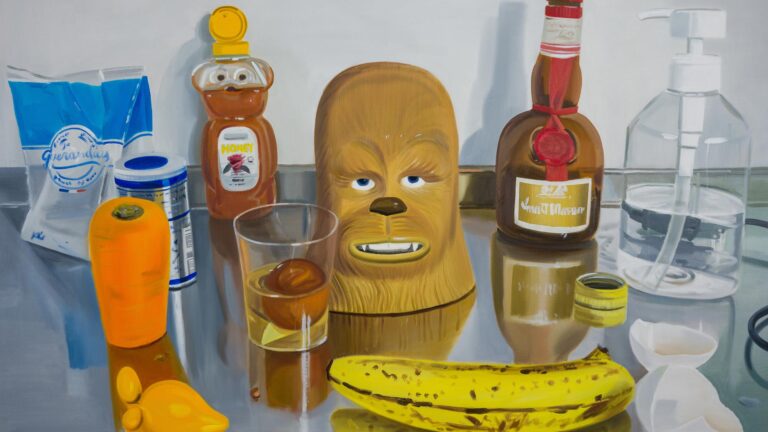Artists: Karolina Bielawska, Peter Brock, Kenji Ide, Stella Zhong
Exhibition title: Seas, nigth skies, and deserts
Venue: Wschód, New York, US
Date: July 12 – August 24, 2024
Photography: Courtesy the artists and Wschód, Warsaw/New York
Seas, night skies, and deserts is an exhibition inspired by the allure of the horizon. Bringing together the work of four artists working across different media, this show invites questions about boundaries. Where do these divisions begin? What role does language play in dividing the world and naming the parts? Do the contoured edges that make up our surroundings mirror those within our patterns of thought? Is it possible to decouple the act of delineating difference from the formation of a binary proposition?
The works in this exhibition invite you to linger with the uncertainty that lurks within the most obvious distinctions: between land and sky, solid and liquid, light and metal, presence and absence.
Karolina Bielawska’s characteristic style centers around a monochromatic palette complemented by carefully selected colors. Her forms offer ambiguous narrative modes: fractal lines and marks, accompanied by biomorphic and asym-metric shapes reminiscing mysterious silhouettes […]
Murmuration, that is, the act of formation of large flocks of birds, through performing rapid synchronic movements during flight that resembles dance, has no unequivocal cause. Perhaps the individuals join into herds to exchange information about feeding sites and to build a sense of security, as organized whirling confuses and distracts potential enemies. However, another hypothesis is charming – the one that suggests that the gathering and communal acrobatics foster an increased generation of heat and the warming up of birds during cold seasons. That is when murmuration takes place most often. Birds move along in spectacular fashion, as a morphing mass without collision, although they have no leader among them. The applicable rules here are those of mutual imitation and a feeling of community. No one really knows how they are able to achieve this.
I saw a man pursuing the horizon;
Round and round they sped.
I was disturbed at this;
I accosted the man.
“It is futile,” I said,
“You can never —”
“You lie,” he cried,
And ran on.
—Stephen Crane, 1905
Annie Godfrey Larmon used the above quote at begining of her essay for Peter Brock’s exhibition An Ear at the Edge of a Chasm at Someday, New York. Brock’s recent paintings are almost always of spheres hovering at a horizon – was then concluded by the writer Brecht Wright Gander. Peter has a particular regard for geometric abstraction, or / and color field compositions. His meticulous, very in fact sculptural process of creating new works, seems to be informed by an abiding interest in materials, and their related histories and processes. It all reveals a craft-oriented methodology in which the notion of abstraction references endless horizons of thoughts and inspirations pushing the works to be a handwrought objects as much as traditional paintings.
One of the Kenji Ide’s works in the exhbition titled “ Another dream on underground” is explained by the artist The horizon has several layers, divided into strata, for example, it is not only above ground but also underground. There are places where human consciousness does not reach, or maybe it is unconscious, but there is time there, for exam-ple. This was an idea that came to me when I imagined New York, and I wanted to create a feeling of a momentary glimpse of the night sky, which, for me, is underground and should not be reflected in the many different layers that are piled up […]
Kenji Ide’s sculptures become intricate organisms of their own. Created using materials like wood, wax or found objects, the sculptures astound with their delicacy. Each referencing a specific memory or place for the artist, they become sketches of his personal world. Despite their deeply personal nature, Ide’s sculptures invite a universal impression of beauty and introspective travel. In that sense, his works are carriers and receivers; they arouse an emotion as well as give space for us to project our thoughts onto them. There is an ongoing exchange taking place in some distant but available subliminal sphere.
Alex Bennet stated Observant of the (in)visibly weird that unsettles perspective, these real enigmas are a window for Stella Zhong, who probes the physicality of consciousness as spatial and dimensional. He then continues her prepositional abstractions shelter particulate matter, little-creviced systems barnacled beneath, between, above, or behind armored forms. Zhong’s cryptic yet vividly sharp, detailed and abstract oriented geometric systems reference at times architectural forms where the particular elements seem to be manipulated and warped, taking on an independence in which their former functionality is implied yet has evaporated. Artist’s sculptural environments quote material irreguralities collaging rythmic spatial dynamics. Zhong builds hermetic worlds with no tangible horizon – the minute we start to process it we are given the impression of another universe lurkin from within. These almost futuristic, unreal, chaotic yet subtle, logical sculptural settings build up the notion of dissorientation making the objects we are confronted with rather surreal and complex organisms.
The artists comments about her own practice that it tends to go from the very boundless, maybe even ridiculous, un-hinged questions about ungraspable things to hyper localized and focused objects. Somewhere in between these two pulling elements, I try to arrive at a possible world.

























